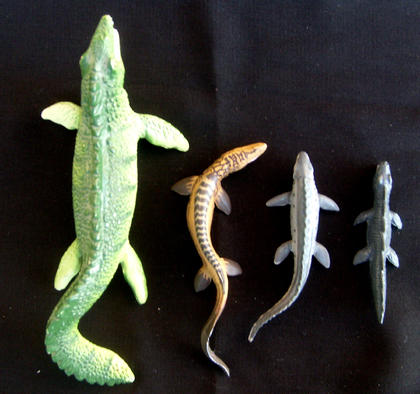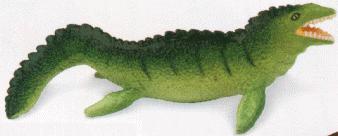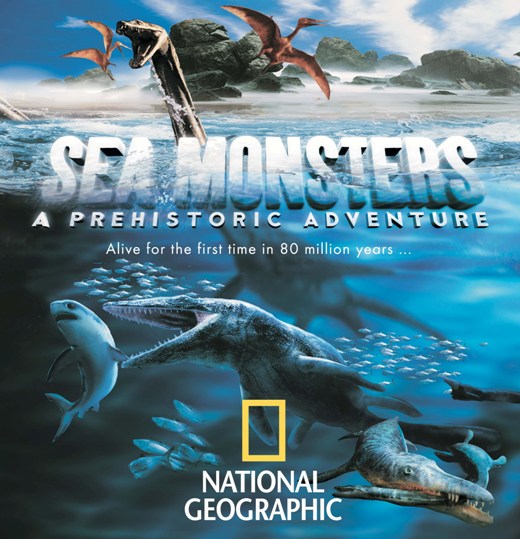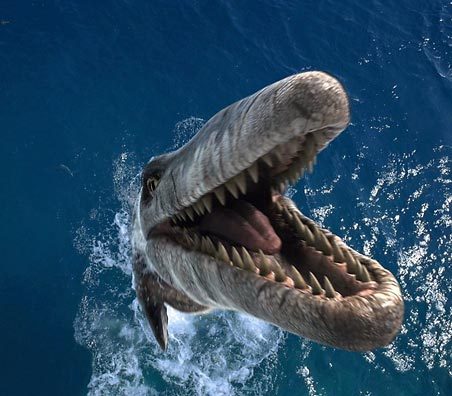
Boki’s mosasaur collection.
August 24, 2009
Updated with newly dated data.
Tylosaurus (Greek for “knob lizard”) was a prehistoric reptile that swam in the shallow seas of the Western Interior Seaway, splitting North America, perhaps even traveling from the Arctic Circle to Central America, about 85-80 million years ago, during the middle-late Cretaceous. These marine reptiles were about 35 to 70 feet long and weighed 7 tons plus. Fossil evidence in the form of stomach contents and associated finds shows they ate fish, turtles and other reptiles.

Safara, Ltd’s 1991 model of Mosasaur.
A type of mosasaur — an aquatic reptile related to modern snakes and monitor lizards — Tylosaurus may have hastened the extinction of less specialized pliosaurs and plesiosaurs, according to most research. Mosasaur skin, btw, has been well-documented since 1878, as Darren Naish discusses in this article, so the effort to capture what they looked like is nothing new.
In recent years, Tylosaurus has been one of the fanciful suggestions for the origins of reports of sea monsters, and, at the end of the 19th century, the concurrent discussions of sea serpent reports as this marine reptile’s discovery was becoming part of popular culture.
In stride, toy manufacturing companies in the 20th century began producing replicas of Tylosaurus, as they were the top predators of the seas. You know how successful Tyrannosaurus rex has been in human art, imagination, movies, and toys, and Tylosaurus filled that niche for the oceans.
Today, we hear from contributor Chema who sends along a graphically supported overview of the question, “How did the Tylosaurus crest evolve in popular culture?”
I thank Chema for granting permission to reprint this, developed from an original Dinosaur Toy Forum message, with my small edits, introductory and framing materials on modern replicas.
The implications for cryptozoology, in understanding the evolution and development of popular cultural imagery, are insightful in Chema’s guest writing, and I appreciate the sharing of this finely illustrated contribution. ~ Loren
+++++++
From Chema:
I have been doing a little research about the history of the design in the reconstruction of the Tylosaurus. I always loved the retro style with the dorsal crests (which made it look like a mythic sea serpent or a sea dragon).
The design of the Tylosaurus crests, however, appears to be strictly a creation of the artists Charles Knight (1874-1953) and, more concretely, Zdeněk Burian (1905-1981).
This is the oldest design I could find of the Tylosaurus. It is a drawing from 1897, by the artist Charles Knight. It has only an extremely minor crest, which is difficult to see, but is there.
Here again, the Tylosaurus was drawn with minor crests, in 1899, by the same artist, Knight. He made it from a skeletal sketch:

There was no evidence of any crests in the skeleton, therefore, Knight invented a line of very little ones along the back of the animal.
In another painting of the Tylosaurus from 1899, again by Knight, the design remains the same, again with some very little crests on the back.
Other artist’s Tylosaurus art emerged between 1900 and 1910, in which they mostly copied Knight’s seminal “little crests” design. (They are not shown here because I want to focus on Kinght’s initial evolution of the design.)
Again here is the same design, by Knight, from 1922:
Then, in 1931, Charles Knight put bigger crests on the species, making it look more mythical, for the following painting in a mural for Chicago’s Field Museum of Natural History:
Zdeněk Burian would follow that path and would make the best design of the Tylosaurus ever, in my opinion, in 1941:
Modern representations of the Tylosaurus eliminated the crests, probably because there was no fossil evidence that supported them. The Tylosaurus again looked more like its first design:
In contemporary popular culture, the Tylosaurus has been depicted following both Knight and Burian styles. For example, as can be seen in these Turok comic books.
Tylosaurus Charles Knight version (very little crests):
Tylosaurus Zdeněk Burian version (big crests):
The Tylosaurus of the Panini replicas (shown below, bottom one of the three) has relatively prominent crests along its back. As no fossil evidence of these exists, more than the late 19th century and early 20th century artwork, this figure surely was designed after the second big crests version of Knight’s, or Burian’s.
~ Chema.
+++
Modern considerations of the lack of crests continue to be reflected in current replicas, and issue forth from the finding that the imagined ridges were merely decomposed collagen and/or misidentified tracheal cartilage, misinterpreted by Knight, Burian, and other artists. ~ Loren

Safari, Ltd’s Carnegie Tylosaurus, 21st Century edition.

CollectA/Procon’s Tylosaurus, 21st Century edition.
The new Tylosaurus imaging was taken to the extreme in the 2007 National Geographic film, the 3D IMAX documentary, Sea Monsters: A Prehistoric Adventure.


A 40-foot-long Tylosaurus (the T. rex of the deep) leaps from the pearlescent depths of immaculately computer-rendered waters directly into your face in Sea Monsters: A Prehistoric Adventure.
Talk about making Tylosaurus come alive!
About Loren Coleman
Loren Coleman is one of the world’s leading cryptozoologists, some say “the” leading living cryptozoologist. Certainly, he is acknowledged as the current living American researcher and writer who has most popularized cryptozoology in the late 20th and early 21st centuries.
Starting his fieldwork and investigations in 1960, after traveling and trekking extensively in pursuit of cryptozoological mysteries, Coleman began writing to share his experiences in 1969. An honorary member of Ivan T. Sanderson’s Society for the Investigation of the Unexplained in the 1970s, Coleman has been bestowed with similar honorary memberships of the North Idaho College Cryptozoology Club in 1983, and in subsequent years, that of the British Columbia Scientific Cryptozoology Club, CryptoSafari International, and other international organizations. He was also a Life Member and Benefactor of the International Society of Cryptozoology (now-defunct).
Loren Coleman’s daily blog, as a member of the Cryptomundo Team, served as an ongoing avenue of communication for the ever-growing body of cryptozoo news from 2005 through 2013. He returned as an infrequent contributor beginning Halloween week of 2015.
Coleman is the founder in 2003, and current director of the International Cryptozoology Museum in Portland, Maine.
Filed under Champ/Lake Champlain Monster, Comics, Cryptomundo Exclusive, CryptoZoo News, Fossil Finds, Lake Monsters, Living Dinosaurs, Loch Ness Monster, Sea Serpents